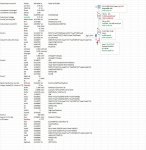Working on a three phase problem (see below).
My questions:
1. Series reactance and resistance stated as per km per phase. Do I need to multiply by sqrt 3 to get line values?
2. I believe I should convert the system to pu - am I on the right lines here?
3. Subject to point 2 above, I am thinking of setting Vbase as 11 kV and VAbase as 1 MVA - is this a good choice or am I off the mark?
4. How do I handle the 1 Ohm resistor on the secondary transformer?
5. To calculate Vr, I am planning to estimate Vr0, then use iterative calculations until no material change in Vr
Thanks as always to the community, I'm learning a lot and appreciate the assistance. Any other guidance or advice gratefully received.
JCB
______________________________________________________________________________________________________________
An isolated three-phase load is supplied from a 33 kV/11 kV substation via a 5MVA transformer with an impedance of 8% (calculated on transformer rating) and a 28 km long three-phase 11 kV overhead line. The overhead line has the following series parameters:
Series inductive reactance = 0.264 ?/km/phase
Series resistance = 0.245 ?/km/phase
Line capacitance and shunt leakage effects may be neglected.
The line supplies a small industrial site fed from a 760 KVA, 11 kV/660 V delta/star transformer with an impedance of 6% (calculated on transformer rating) and negligible resistance. The transformer secondary is earthed via a 1? resistor.
The site has a load of 640 kVA at a power factor of 0.96 lagging. The voltage at the 33kV bus at the substation (
[FONT=Times New Roman,Times New Roman][FONT=Times New Roman,Times New Roman]V[/FONT][/FONT][FONT=Times New Roman,Times New Roman][FONT=Times New Roman,Times New Roman][/FONT][/FONT]s) is maintained at 33.3kV and the 33kV fault level at the substation is 580 MVA.
[FONT=Times New Roman,Times New Roman][FONT=Times New Roman,Times New Roman][/FONT][/FONT][FONT=Times New Roman,Times New Roman][FONT=Times New Roman,Times New Roman][/FONT][/FONT]
My questions:
1. Series reactance and resistance stated as per km per phase. Do I need to multiply by sqrt 3 to get line values?
2. I believe I should convert the system to pu - am I on the right lines here?
3. Subject to point 2 above, I am thinking of setting Vbase as 11 kV and VAbase as 1 MVA - is this a good choice or am I off the mark?
4. How do I handle the 1 Ohm resistor on the secondary transformer?
5. To calculate Vr, I am planning to estimate Vr0, then use iterative calculations until no material change in Vr
Thanks as always to the community, I'm learning a lot and appreciate the assistance. Any other guidance or advice gratefully received.
JCB
______________________________________________________________________________________________________________
An isolated three-phase load is supplied from a 33 kV/11 kV substation via a 5MVA transformer with an impedance of 8% (calculated on transformer rating) and a 28 km long three-phase 11 kV overhead line. The overhead line has the following series parameters:
Series inductive reactance = 0.264 ?/km/phase
Series resistance = 0.245 ?/km/phase
Line capacitance and shunt leakage effects may be neglected.
The line supplies a small industrial site fed from a 760 KVA, 11 kV/660 V delta/star transformer with an impedance of 6% (calculated on transformer rating) and negligible resistance. The transformer secondary is earthed via a 1? resistor.
The site has a load of 640 kVA at a power factor of 0.96 lagging. The voltage at the 33kV bus at the substation (
[FONT=Times New Roman,Times New Roman][FONT=Times New Roman,Times New Roman]V[/FONT][/FONT][FONT=Times New Roman,Times New Roman][FONT=Times New Roman,Times New Roman][/FONT][/FONT]s) is maintained at 33.3kV and the 33kV fault level at the substation is 580 MVA.
[FONT=Times New Roman,Times New Roman][FONT=Times New Roman,Times New Roman][/FONT][/FONT][FONT=Times New Roman,Times New Roman][FONT=Times New Roman,Times New Roman][/FONT][/FONT]





